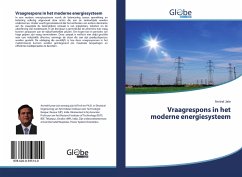
Demand Response in Modern Power System
Versandkostenfrei!
Versandfertig in 6-10 Tagen
24,99 €
inkl. MwSt.

PAYBACK Punkte
12 °P sammeln!
In modern power system, the balancing between generation and load is done entirely through actions taken from the supply side. Further, it is observed that the absence of active demand-side participation is the main cause of price spikes, shortages and exercise of market power. It has been reported in the literature that the buyers can adjust their demand in response to the time-varying prices. A buyer may like to reduce its demand during periods of high prices. This approach may not be always suitable for an industrial buyer, due to requirement of its production process. The challenge that re...
In modern power system, the balancing between generation and load is done entirely through actions taken from the supply side. Further, it is observed that the absence of active demand-side participation is the main cause of price spikes, shortages and exercise of market power. It has been reported in the literature that the buyers can adjust their demand in response to the time-varying prices. A buyer may like to reduce its demand during periods of high prices. This approach may not be always suitable for an industrial buyer, due to requirement of its production process. The challenge that remains is how to incorporate these demand responses into market design to achieve the maximum savings and efficient market performance.












